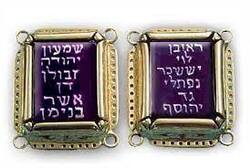 The names of the 12 Tribes were engraved on the Shoham (onyx) stones affixed to the shoulder straps of the Ephod. 6 names were written on each stone, as taught in the Torah; ששה משמותם על, “six of the names on [one stone]”. The division and spelling of the names ensured that there were exactly 25 letters on each stone. The first letters of these words ששה משמותם על spell שמע - Shema.[1] The verse Shema Yisroel has 25 letters. The two stones with 25 letters each, represent the two times each day that we are commanded to recite the Shema; once in the morning and once at night. The stone on the right side corresponds to the attribute of Chessed. This represents the morning Shema which is recited at a time of light and revelation. The left stone corresponds to the attribute of Gevurah. This represents the evening Shema, recited at a time of concealment, darkness and challenge. In the first verse of the Shema, we accept upon ourselves Hashem’s kingship and surrender ourselves to Him. Day and night also represent different phases in our lives. When the sun shines on us and we experience physical and spiritual success, we feel secure and it is easy to forget about Hashem, as we attribute our success to our own doing. In our ‘daytime’ we need to say Shema, to humble ourselves and recognise the true source of our blessings. Likewise, when we struggle with darkness and go through hard and challenging times, we feel down and alone. In this state it is hard to find motivation to serve Hashem. In our ‘night-time’ we need to say Shema, to realise that we are not alone and that Hashem is in control and there for us when we turn to Him. This is the inner message of the two Shoham stones on the side of Chessed and the side of Gevurah. No matter what circumstances or stage of life that we find ourselves in, be it bright or dark, we are able to and need to say Shema, our connection to Hashem. [1] Or Hatorah Tetzaveh p1667
0 Comments
Leave a Reply. |
All posts
Read today's Beis Hamikash Thought Archives
July 2023
|
